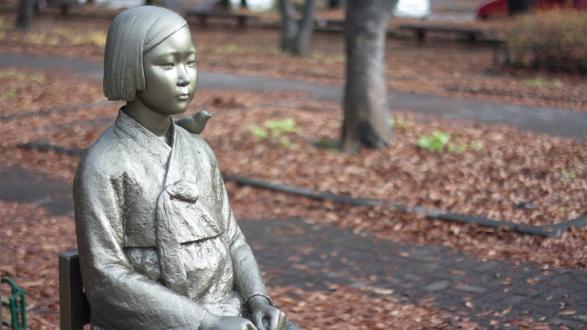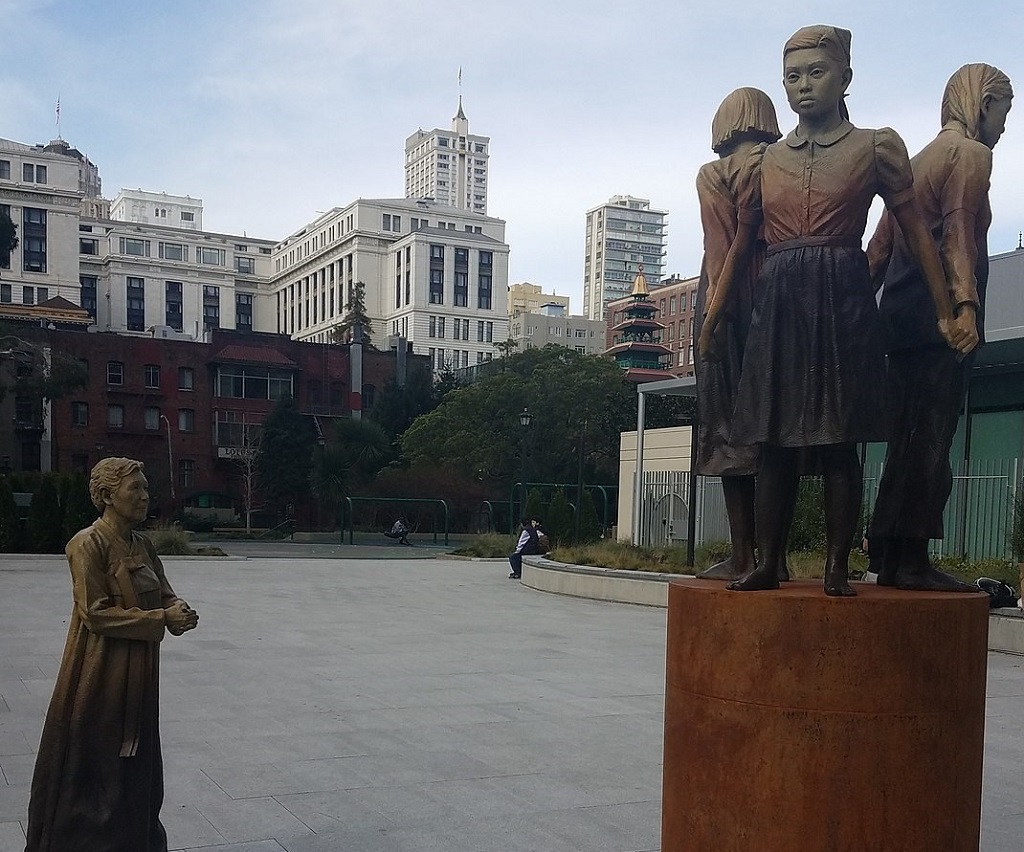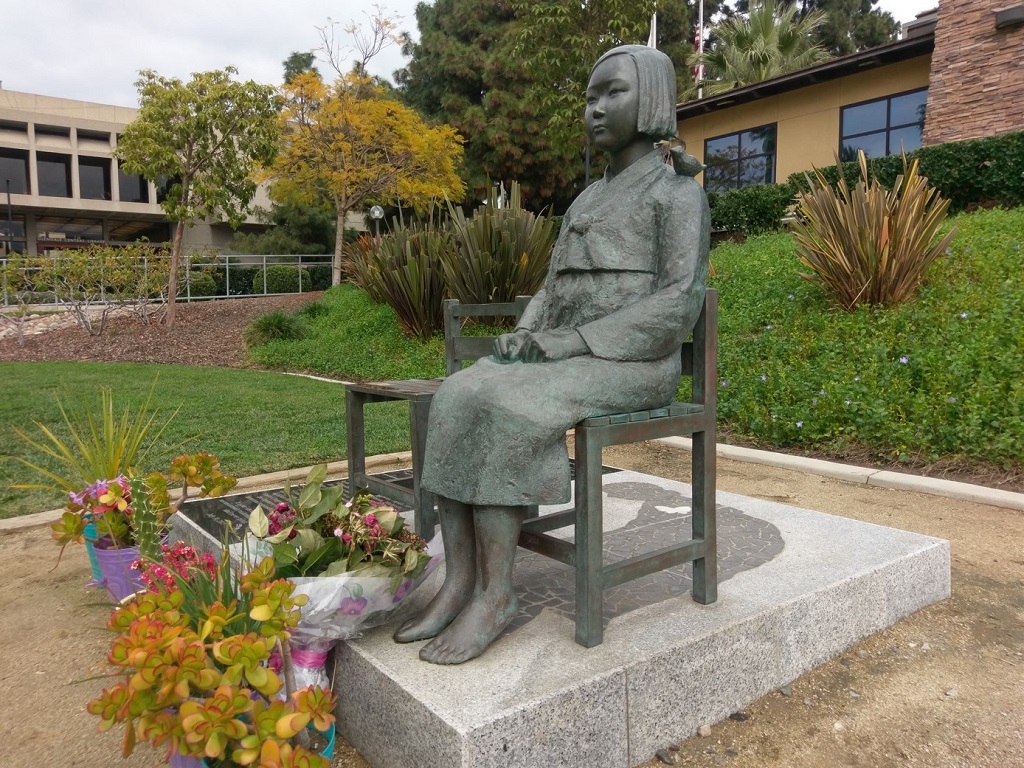It has been one year since the first statue honoring "comfort women" was erected in San Francisco, California. The Women’s Column of Strength pays tribute to the hundreds of thousands of women forced into sexual enslavement by the Imperial Japanese Army during World War II.
"You’d think honoring comfort women would be a no-brainer," said Judith Mirkinson, president of the Comfort Women Justice Coalition, the group that funded the statue. "But it turns out a lot of people, especially the Japanese government, are extremely opposed."
Women’s Column of Strength in San Francisco, California erected September 22, 2017
Korean survivor Hwang So-gun thought she was going to work at a factory when she was taken to a comfort station at the age of 17, according to a United Nations report. "Every night I was assaulted by 15 to 20 men," she said. "We had to undergo medical examinations regularly. Those who were found disease-stricken were killed."
The first comfort station opened in 1932 and the number expanded rapidly following the Rape of Nanking in 1937. According to a book by Chunghee Sarah Soh, a professor of anthropology at San Francisco State University, the Japanese army believed such facilities would reduce rapes committed against women in occupied territories.
Both local Japanese-Americans and the Japanese government cite fears San Francisco’s memorial could provoke renewed discrimination, recalling the U.S. internment camps of World War II.
Both local Japanese-Americans and the Japanese government cite fears San Francisco’s memorial could provoke renewed discrimination, recalling the U.S. internment camps of World War II.
"Opponents like the Global Alliance for Historical Truth were present at every public hearing for this statue," explained Linda Hasunuma, visiting assistant professor of political science at the University of Bridgeport. "They have resources and organization to counter comfort women monument supporters."
Most recently, Osaka Mayor Hirofumi Yoshimura reiterated last year’s threat to end his city’s 60-year Sister City relationship with San Francisco if the statue was not removed by the end of September. "Uncertain and one-sided claims are inscribed onto the Comfort Women Memorial plaque as historical fact," Yoshimura argued in his letter to San Francisco Mayor London Breed.
When the statue was unveiled in September 2017, Jun Yamada, the Consul General of Japan in San Francisco, said in a statement that comfort women monuments "are rapidly alienating the entire Japanese public, who could otherwise be sympathetic to the wartime plight of these women, by unduly exacerbating emotional antagonism."
The intent of the San Francisco statue was not to offend or provoke the people of Japan, Mirkinson explained. "A pan-Asian, multi-generational group came together to build this statue to highlight the issue of rape during war," she said. "This is about way more than Korean-Japanese diplomacy."
Kim Hak-sun, a leader in the movement behind Glendale’s comfort women monument, maintains the purpose of statue is to "educate and remind the public that rape during wartime is a current issue" the global community must face.
Efforts to build this statue were spearheaded by San Francisco’s Chinese-American community, including former city supervisor Eric Mar. Three Chinese, Filipino and Korean girls hold hands while the likeness of activist Kim Hak-sun, the first Korean woman to testify about her experience as a comfort woman in 1991, looks on.
"These monuments are linked to the greater transnational movement to include women’s experiences during wartime," Hasunuma said. The San Francisco monument is the ninth honoring comfort women in the United States. The first memorial was built in Palisades Park, New Jersey, in 2010. Another was built in Glendale, California, in 2013. Others have since been built in nations including Australia, Germany, and Taiwan.
Ten countries are listed in an inscription beside the comfort woman statue in Glendale to highlight the many nationalities of women abducted by the Imperial Japanese Army. "She is a Korean girl, but she represents all women," said Phyllis Kim, director of the Korean American Forum of California.
Peace Monument erected in Glendale, California in 2013. This is a replica of the Statue of Peace located in Seoul, South Korea
As in San Francisco, the Japanese government lobbied Glendale’s city council to reject the statue as misleading and antagonistic. The Japanese Consul General wrote an op-ed for the LA Times, and local Japanese-Americans filed an unsuccessful lawsuit against the city.
Kim, a leader in the movement behind Glendale’s comfort women monument, maintains the purpose of statue is to "educate and remind the public that rape during wartime is a current issue" the global community must face. The Korean American Forum of California subsequently led a successful campaign to include comfort women in California’s 10th grade history curriculum.
"Victims of rape don’t have a voice because the violence is seen as normal, justifiable during war," Kim said. "Comfort women did not come forward for 50 years because of the shame."
As San Francisco’s Comfort Women Justice Coalition celebrates the first anniversary of the Women’s Column of Strength, Mirkinson reiterates that no level of opposition could quell activists now. "The importance of what the comfort women did in breaking their silence is huge," she said. "Sharing their stories has and will continue to empower present and future women to do the same."
_____________________
Mikayla Bean is a USC graduate student participating in a foreign affairs reporting class taught by Professor Phil Seib, a collaboration between the Pacific Council and the Annenberg School of Communication and Journalism.
The views and opinions expressed here are those of the author and do not necessarily reflect the official policy or position of the Pacific Council.






